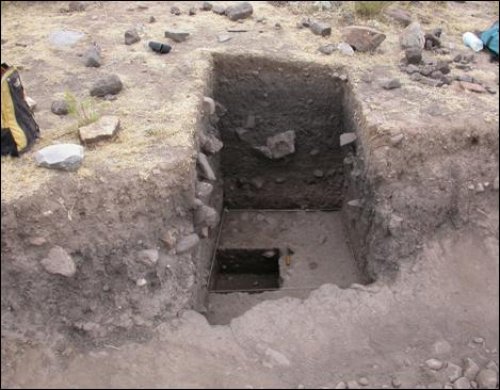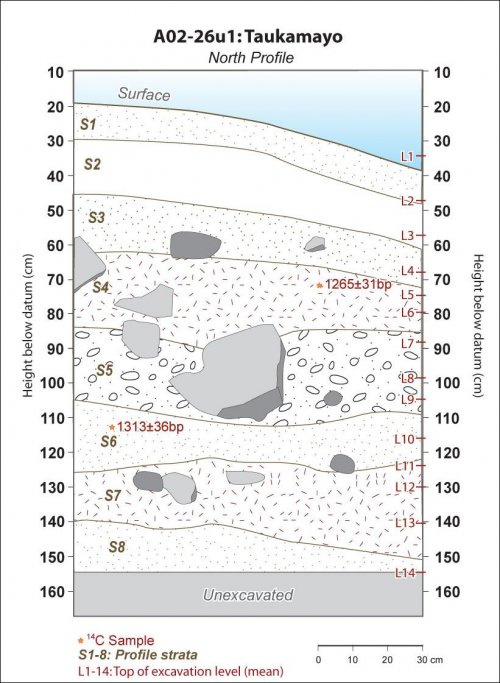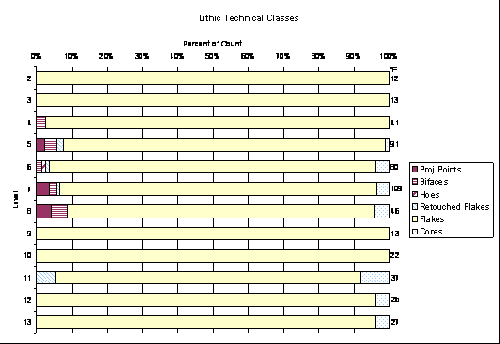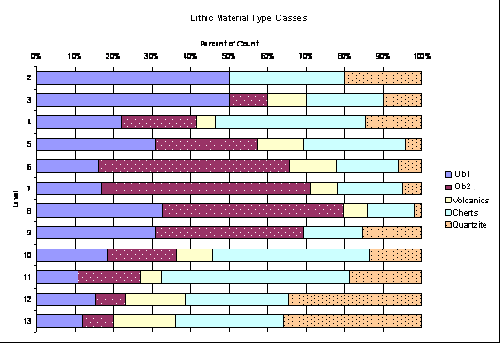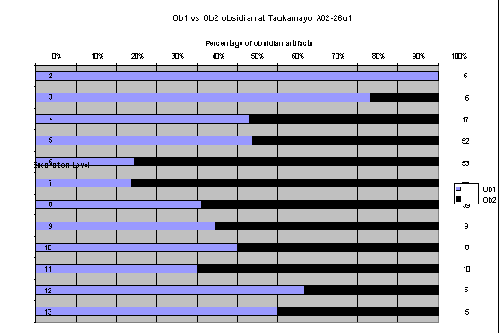7.6.1. A02-26, Test Unit 1
The site of Taukamayo contains archaeological materials in a variety locations on the site as described in Section 6.4.3, including the profile of a cut on the edge of a low-angle, creeping rainy-season landslide. In the cut profile carbon, lithics, bone, and ceramics were identified at approximately 45 cm below the ground surface. A test unit was placed on the undisturbed edge of the landslide
Stratigraphy
Inspection of the slope cut and the stratigraphy of the test unit confirmed that the site had not slid in the past and the stratigraphy was largely intact. There are signs of increasing angle of deposition through time. Sloping, colluviated soils gave way to level, well-sorted gravels near the bottom of the cultural levels. Radiocarbon dating indicated that the deposit is largely synchronic as the two sigma error of the radiocarbon samples overlap.
Figure 7-36. Test unit A02-26u1 is a 1x1m test unit placed on the edge of a creeping landslide with an irregular extension area (1x) on the south edge of the unit. Top of the photo is north.
The TU1 was placed immediately north of the cut slope, but because it was oriented to true north there was a small irregular, extra section to the south of the unit that dubbed A02-26u1 x. As a cut profile was available it was possible to observe that the ~60cm of overburden above the charcoal, bone, lithic, and ceramic layer in the profile was virtually sterile. The overburden was excavated relatively expediently by only screening only one-quarter of the dirt through 1/16" screen, the rest went through 1/4" screen only. By level 3 (58cm below datum) everything was screened through 16" screen.
|
Level |
H.B.D.* |
Contents |
Soil |
Photo # |
|
1 |
30 cm |
S1: All: 1/4" screen, Quad D: 1/16" screen. Few artifacts. |
Top of unit, grass, roots, light brown soil. |
3528 |
|
2 |
47 |
S2: All: 1/4" screen, Quad D: 1/16" screen. Few artifacts. |
Dark grey 7.5YR4/1. Compacted, organically rich, poorly-sorted, subangular .3/.9. |
3529 |
|
3 |
58 |
S3: All quads through 16" screen from here downward. Few artifacts. |
V. Dk Grey 7.5YR3/1, subangular blocky, med grain, poorly sorted, .7/.3 |
3532 |
|
4 |
65 |
S3, S4: 1, 0a (matrix). Rocks, roots, charcoal, bone, yellow clay blob. 14C: 1265±31bp (AD660-830) |
F1: Alluvial, V. Dk Grey/Brown: 10YR3/2, med grain, well-sorted,.5/.3. F2: 7.5YR3/1, med grain, well-sorted, .7/.3 |
3538-3541 |
|
5 |
75 |
S4: F1,F3. Bone, ceramics, many lithics, charcoal. |
F1: V. Dk Grey 7.5YR4/1, subangular blocky, coarse, poorly sorted, .9/.7 |
3546 |
|
6 |
80 |
S4, S5: F1. Bone, ceramics, many lithics, charcoal. Top of hoe. |
V. Dk Grey 7.5YR3/1, subangular blocky, med grain, poorly sorted, .7/.3 |
|
|
7 |
88 |
S5: F1, F3. Much bone on west side of unit, lithics, andesite hoe |
F1 and F3: V. Dk Grey 7.5YR3/1, coarse grain, poorly sorted, .7/.3 |
3573-3576 |
|
8 |
98 |
S5: F1, F4. Bone, ceramics, many lithics, charcoal, midden. |
F1: Alluvial, V. Dk Grey/Brown: 10YR3/2, med grain, well-sorted,.5/.3. F2: 7.5YR3/1, med grain, well-sorted, .7/.3 |
3600 |
|
9 |
105 |
S5, S6: F1, F4. In F4 there was ochre and obsidian, but less bone. 14C: 1313±36bp (AD650-780) |
F1 and F3: V. Dk Grey 7.5YR3/1, coarse grain, poorly sorted, .7/.3 |
3666-3667 |
|
10 |
116 |
S6: F1,F5. Lithics, ceramics, bone |
F1 and F5: V. Dk Grey 7.5YR3/1, coarse grain, poorly sorted, .7/.3 |
3673 |
|
11 |
124 |
S6, S7: Arbitrary div: 1a, 1b. Lithics, ceramics, bone |
F1 and F5: V. Dk Grey 7.5YR3/1, coarse grain, poorly sorted, .7/.3 |
3675 |
|
12 |
130 |
S7: Arbitrary div: 1a, 1b,1x. Mixed midden, charcoal, lithics, 2 clay concentrations |
Moist soils. V. Dk Grey 7.5YR4/1, subangular blocky, med. grain, med. sorted, .9/.7 |
3677 |
|
13 |
141 |
S7: Arbitrary div: 1a, 1b,1x Few lithics, 1 sherd, no bone |
Very moist soils. V. Dk Grey 7.5YR4/1, subangular blocky, med. grain, med. sorted, .9/.7 |
3679 |
|
14 |
156 |
Compact soil |
3684 |
|
|
* HBD = mean height below datum in centimeters for the top of each level based on five depth measurements. |
||||
Table 7-31. A02-26u1 test unit. Excavation levels, overview, and soil description.
Figure 7-37. A02-26u1 Taukamayo test unit, north profile diagram showing strata and levels.
The stratigraphy at A02-26u1 revealed that the site was intact behind the profile as no obvious landslide had disturbed the soils. There was a distinct change in angle approximately 60-80cm below the surface where the strata are at a much lower angle. These strata contain a great deal of charcoal and bone, and the radiocarbon dates place the assemblage at approximately AD700. This is the middle of the Tiwanaku period and it represents the beginning of the Middle Horizon. The slope angle change that is suggested by the soil stratigraphy is likely related to changes in the position or altitude of the adjacent creek. Evidence of alluvial sorting and river smoothed stones were also found in strata below the S4 and S5 occupation, which suggest that these occupations are on top of an old river terrace. Today, Taukamayo creek is approximately 40m vertical below the site altitude, and denuded hillslopes around the creek suggest that erosion is severe in this tributary valley to the Colca. A preliminary assessment is that Taukamayo creek has significantly incised since the Late Formative and Middle Horizon when it flowed below the site of A02-26 which lay on a relatively flat T1 terrace. Increased incising of Taukamayo creek first caused soil deposition to assume steeper angles, as is apparent in the upper 60cm of the profile. However in the more recent past the creek has begun to undercut the T1 terrace on which the site rests and the southern part of Taukamayo has since slid, revealing the profile cut.
Artifacts by level
Obsidian arrives into the test unit area in conjunction with bones, both burned and unburned, that turned out to be primarily camelid bones. The lithic analysis evidence suggests that obsidian was brought into the area around level 8 where the mean flake size is considerably higher than average and obsidian goes from an average 55% of the lithic assemblage by level, to 80% of the assemblage in level 8 and then 70% of the assemblage in level 7.
|
Obsidian |
Non-obsidian |
||||||
|
Level |
Possible Bifacial Thinning |
No. |
Ave. Rotations |
Ave. Cortex |
No. |
Ave Rotations |
Ave Cortex |
|
2 |
5 |
0 |
0 |
5 |
0 |
18.0 |
|
|
3 |
6 |
0 |
0 |
4 |
0 |
17.5 |
|
|
4 |
17 |
0.4 |
1.2 |
24 |
0 |
7.9 |
|
|
5 |
6 |
51 |
0.6 |
1.6 |
39 |
0.2 |
4.9 |
|
6 |
2 |
53 |
0.3 |
1.5 |
27 |
0.4 |
9.6 |
|
7 |
7 |
79 |
0.3 |
1.8 |
32 |
0.1 |
3.4 |
|
8 |
1 |
38 |
0.3 |
4.7 |
10 |
0 |
7.0 |
|
9 |
1 |
9 |
0.3 |
0 |
4 |
0 |
2.5 |
|
10 |
8 |
0.1 |
0 |
14 |
0.2 |
7.1 |
|
|
11 |
10 |
0.3 |
6.0 |
27 |
0.3 |
12.2 |
|
|
12 |
6 |
0.5 |
8.3 |
20 |
0.2 |
15.0 |
|
|
13 |
5 |
0.2 |
2.0 |
20 |
0.2 |
15.5 |
|
|
Total |
17 |
287 |
0.3 |
2.2 |
226 |
0.2 |
9.0 |
Table 7-32. A02-26u1: Artifact counts and averages for select measures.
|
Proj Points |
Bifaces |
Cores |
Retouched Flakes |
Flakes |
Total |
|
|
Level |
No. |
No. |
No. |
No. |
No. |
|
|
2 |
10 |
10 |
||||
|
3 |
10 |
10 |
||||
|
4 |
1 |
40 |
41 |
|||
|
5 |
2 |
3 |
1 |
2 |
82 |
90 |
|
6 |
1 |
3 |
1 |
75 |
80 |
|
|
7 |
4 |
2 |
4 |
1 |
100 |
111 |
|
8 |
2 |
2 |
2 |
42 |
48 |
|
|
9 |
13 |
13 |
||||
|
10 |
22 |
22 |
||||
|
11 |
3 |
2 |
32 |
37 |
||
|
12 |
1 |
25 |
26 |
|||
|
13 |
1 |
24 |
25 |
|||
|
Total |
8 |
9 |
15 |
6 |
475 |
513 |
Table 7-33. A02-26u1: Lithic Technical Classes by Level showing counts.
Figure 7-38. A02-26u1 Technical Class by Excavation Level.
Figure 7-39. A02-26u1 Material Types by Excavation Level.
Figure 7-40. Obsidian at Taukamayo A02-26u1, Ob1 and Ob2 compared.
Material types at Taukamayo provide insights regarding the use of non-obsidian lithic material in the vicinity of the Chivay source. Chert is abundant in the Colca and the Llapa rivers, and in Taukamayo creek. Yet the reduction in imported obsidian appears to have occurred at a few distinct sites in the Upper Colca valley area, as if complementing the local chert use.
The use of Ob1 and Ob2 obsidian at Taukamayo is also informative. The influx of obsidian in levels 6-8 appears to have been from a source with Ob2 obsidian as both types of obsidian increase in these levels but the percentage of Ob2 obsidian is significantly greater than it was in previous and later levels. In the course of survey work, Ob2 obsidian was encountered outside of the Maymeja zone in Block 4, and also at a minor obsidian source in the Pulpera drainage called Condorquiña (Section 4.5.1). It is possible that the Ob2 obsidian was derived from one of these sources, and that this lower quality obsidian was generally not intended for projectile point production. In fact, projectile points are comparatively rare at Taukamayo, with only 8 obsidian projectile points and preforms coming from the TU1 pit, and of these only one point (in level 7) was Ob2 material. This evidence suggests that the focus on obsidian production in this area in the beginning of the Middle Horizon was on flake and biface production, and there was relatively little preference shown for Ob1 obsidian over Ob2 material.
In level 5, there appears to have been more advanced reduction of obsidian occurring. The BTF index suggests that bifacial thinning flakes are more prevalent than in other levels, and 3 broken bifaces (50% of total) were found in level 5, the average number of rotations went from 0.36 to 0.56 in level 5 implying that greater conservation of material was occurring in that level.
Figure 7-41. Cumulative frequency comparing obsidian and non-obsidian flakes.
Levels 5 and 6 also contained a high density of animal bone. Analysis of diagnostic faunal remains by Randi Gladwell revealed that the majority of the bones were camelid, and though some small mammal bones were encountered that may have been cuy(guinea pig) or viscachabones. Comparing obsidian with non-obsidian overall, it is apparent that more advanced reduction occurred on obsidian. This contrast is expressed in Figure 7-41 where over 80% of obsidian flakes are under 1.7g in weight.
Comparing Material Types in A02-26u1 and Block 3 overall
The excavation unit A02-26u1 at Taukamayo presents lithic evidence, albeit synchronic to the Tiwanaku period, that is, in some ways, representative of the material use pattern in Block 3 overall. Distinct patterns emerge, however, with respect to the use of Ob2 obsidian, because as was noted Ob2 obsidian was rarely used outside of Block 3.
|
A02-26u1 Excavation |
Block 3 total surface collection |
|||||||
|
Ob1 |
Ob2 |
Ob1 |
Ob2 |
|||||
|
No. |
% |
No. |
% |
No. |
% |
No. |
% |
|
|
Proj Points |
7 |
87.5 |
1 |
12.5 |
24 |
96.0 |
1 |
4.0 |
|
Bifaces |
2 |
25.0 |
6 |
75.0 |
16 |
69.6 |
7 |
30.4 |
|
Rt'd Flakes |
1 |
33.3 |
2 |
66.7 |
9 |
52.9 |
8 |
47.1% |
|
Flakes |
101 |
38.7 |
160 |
61.3 |
32 |
49.2 |
33 |
50.8 |
|
Cores |
3 |
33.3 |
6 |
66.7 |
15 |
88.2 |
2 |
11.8 |
|
Total |
114 |
39.5 |
175 |
60.6 |
96 |
65.3 |
51 |
34.7 |
Table 7-34. A02-26u1 Excavation and Block 3 surface: Lithic Tech. Classes by Obsidian type.
Table 7-34 shows that Ob1 obsidian was primarily used for projectile point production, however bifaces from Ob2 were used to a much greater extent at A02-26u1. Retouched flakes of the two material types were used in similar proportions in the two contexts.
Discussion
This test unit appears to show several occasions of obsidian reduction in conjunction with camelid butchering and cooking during the earliest part of the Tiwanaku period at this site in the upper Colca. More advanced reduction was occurring on obsidian, but there appeared to have been little preference for Ob1 obsidian over the Ob2 material, and in fact in the production of bifaces it appears knappers used Ob2 preferentially, though both materials were available. The Uyo Uyo obsidian source is under 40 km downstream and there are irregularities in Uyo Uyo material that such that it falls in the Ob2 category.
As dates contemporary with Tiwanaku were derived from this unit, a regional consideration of this occupation should include the distributions of Chivay obsidian in this time period. Regional distributions indicate that during the Tiwanaku period Chivay obsidian was rarely used north of Chivay source area. Distributions tend strongly towards the south and east where the Lake Titicaca Basin consumption pattern is strongest. Yet it is curious that the highest density of obsidian in the Block 3 area north of the source is dated to the Tiwanaku period, which is in a northward direction and towards the Wari sphere. In concordance with regional obsidian distributions in this time period, it is notable that the heavy use of Ob2 obsidian, and the production of bifaces rather than projectile points, suggests that goods produced at this obsidian production area use were intended for modest local consumption.
